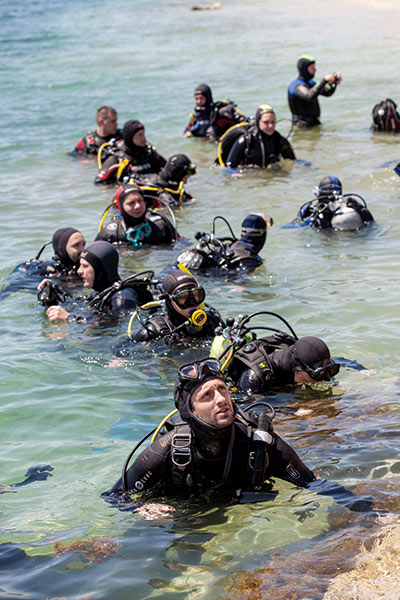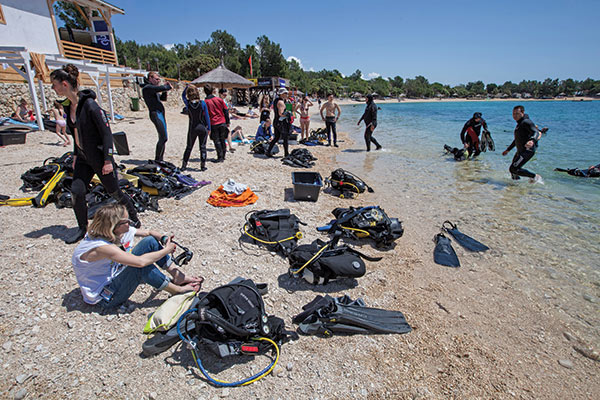Dust off those fins!
Will reactivate initiatives lead to a SCUBA renaissance?
Text by Robert Osborne, photography by Jill Heinerth

It was a magical moment that Wendy Truman will never forget: the end of a dive in Belize. She was hanging on the down line for a safety stop “when I heard a kind of quacking sound.” A pod of five dolphins appeared, circling her group. “We had plenty of air so our dive master let us play with them.” She spent the next 20 minutes gliding along at 30 feet (9m) while the dolphins finned around the delighted divers.
For Alan Williamson, the magic happened in Monterey Bay. He and his partner were in amongst the kelp beds. “The visibility was crystal clear, my buoyancy was perfect. It was like flying through an underwater forest.” Just when he thought the dive couldn’t get any better, sea lions decided to check them out. They all swam together for the rest of the dive. It was an unforgettable experience in his diving life.
Alexa Louie remembers a trip to Green Turtle Key in the Bahamas. The local dive operator had thrown some fish heads over the side of the boat just before they jumped in. Almost immediately reef sharks and groupers were flashing among the coral heads, surrounding the divers. A little nervous at first, Alexa soon realized the sharks were interested in the fish so she hung there in the water captivated by all the action. The experience remains vivid.
Wendy, Alan and Alexa have something more in common besides these indelible memories; they’re all re-certified. Each had become certified, but over time they’d drifted away from the sport. Wendy (NAUI 1982) says it was mostly the expense but adds “I had hearing problems, an inner ear virus, so I’ve been really protective of my ears.” Alan (PADI 1971) says, “Cost was the primary factor.” Alexa (PADI 2003) says she just got bored with diving and wanted to explore other activities like the martial arts.
At the end of the class, the consensus was they couldn’t wait to get back into the water and start diving again
Statistically, this trio is the norm. Between 40 percent (PADI) to 80 percent (Undercurrent) of all divers leave the sport after three years. Even the low number in this range represents a significant diver dropout rate. According to NAUI Training Manager Randy Shaw, this occurs because of increased competition from other adventure sports. “In the 60s when diving was at its highest growth rate, we didn’t have these competing sports…growth from competition has hurt us the most,” he tells me.
Industry spokespeople concur that all sports plateau or take a downturn that affects enrollment. In the 1990s growth in snow skiing plateaued. But snowboarding had a positive impact on all facets of that winter recreation industry. In a similar way, technical diving is a breakaway pursuit that supports recreational sport diving.

Could sport diving benefit from a new champion, real or imagined, as we had with Jacques Cousteau or even Sea Hunt TV star Lloyd Bridges? Some people think so. Both of these diving personalities figured prominently in the public imagination back in the early days of SCUBA diving, and helped the new aquatic activity to gain in popularity and grow its numbers.
Growth has slowed. Outdoor recreational sport options today offer consumers many more places to spend discretionary income. And, let’s face it, for lots of younger people, focus has narrowed from physical to virtual participation in one sport or another thanks to the ubiquitous and feature-rich mobile device. Of course, demographics are a factor. So, dropping out will remain a fixture, as ever, but the rate can be affected with the right initiatives.
PADI says it has certified 23 million divers around the world since 1967 (900,000 per year averaged). Forty per cent of that is a massive pool of lapsed divers to tap into. A PADI survey targeting 400,000 inactive divers was revealing. Ninety-eight percent of respondents said they were interested in getting back into the sport. That’s good news, and good business, too. It’s easier and less expensive to retain a customer than to recruit a new one.
So it’s little wonder that North America’s four big certifying agencies (PADI, NAUI, SSI and SDI) are all eager, and focused, on getting ‘lapsed’ divers back in the water. PADI was first out of the starting blocks with its ‘ReActivate’ program, noting, “A convenient program which addressed the needs would encourage divers to return to diving. So the PADI instructional design and technology team went to work developing ReActivate.”
PADI’s ReActivate
Here’s how their program works. Lapsed divers can either download an app—ReActivate Touch—or work online with a program that allows them to access custom-designed refresher courses. As they answer questions correctly, the program gives them the chance to review theory and skills that they specifically need to work on. Once that’s complete they can link up with their local dive shop to complete what amounts to a tailor-made confined or open water session. Given by anyone with Dive Master certification and up, the practical sessions are designed to address the skills each lapsed diver needs to work on. On successful completion they earn a new C-card that shows original and ReActivate certification dates. Simple and effective, the program isn’t limited to one pass. If your certification should lapse again, you can retake the course. PADI Worldwide CEO and President, Drew Richardson, describes the program as “clear, enjoyable and robust…designed to guide them back.”
A recent ReActivate class run by Aquarius Scuba in Toronto underscored this. Among the enrollees keen to get back into the water were Dave Good (last dive in 2013) soon off to Australia and keen to dive the Great Barrier Reef; Ashley Motran (lapsed since 2005) heading for a family reunion in Fort Lauderdale and motivated to be on the dive boat with everyone else; and Peter Machuca (last dive in 2007), newly arrived in Toronto from California and excited to start diving again in the absence of surfing.

Instructor Andrea Drentsios put the students through their paces. Everything is covered from a refresher on how to set up your gear to all the fundamental skills required once you’re in the water. At the end of the class, the consensus was they couldn’t wait to get back into the water and start diving again. Mission accomplished.
NAUI
PADI isn’t the only agency that’s seen the potential of lapsed divers. NAUI’s Randy Shaw says, “We’re spending a truck loan of money to get people back.” But NAUI’s emphasis is slightly different. First of all they’re focusing on younger divers. Shaw states, “Our youth is fat, numb and happy sitting on the couch playing video games…we have to find a way to get people off the couch.” And secondly, NAUI has directed its push to online initiatives—redesigned web sites and program offerings. Shaw says, “We’ve just contracted out a full redesign of our web page.”
SSI
SSI is following a similar course of action. Sage Dalton, SSI Director of Education says, “We want to speak the language of younger students… and that’s digital.” So, like NAUI, they’re ramping up their online appeal. SSI has launched its #REALDIVING initiative to make their courses more accessible on line. They’re also working on a digital version of their Scuba Skills Update program to tie in to #REALDIVING.
TDI/SDI
TDI/SDI Senior Vice President, Shawn Harrison, says they’ve always been aware of the need to attract divers back into the fold. He says, “We’re always trying to keep divers engaged.” Their approach is more “a stay the course plan.”
Response to these certifying agency initiatives has been mostly positive. Matt Mandziuk of Dan’s Dive Shop in St. Catharines, Ontario, thinks ReActivate is a brilliant idea. He says, “This program absolutely can be an economic benefit to the industry.” But he adds, “We need to find a way to re-connect with the lapsed people…there are some limitations because of anti-spam laws… we can’t just randomly email.”
Bobby Purifoy of Olympus Dive Centre in Moorehead City, North Carolina, thinks any attempt to reach lapsed divers is sound business. “It doesn’t hurt to knock on the door,” he says. “When you’re looking at a small industry like diving, you can’t afford to ignore any segment of the market.” He notes a great trend of late that he’s seen is of parents returning to be re-certified and bringing their families along for the experience. Norbert Pietkiewicz and Jessica Templin of Aqua Sub Diving in Richmond Hill, Ontario, think lapsed divers could add up to 15 percent of their total business. They’re fans of the ReActivate program saying it “isn’t intimidating to lapsed students…they don’t have to do the whole course again, so it’s more inviting.” They’re also seeing lapsed students return with their families and happily “buying multiple sets of gear.”
At least one dive manufacturer sees the push to reach lapsed divers as a move in the right direction. Alex Taylor of Shearwater Research says, “Anything that makes the dive industry stronger is better for us…so yeah it’s a move in the right direction.”
What’s the Right Pitch?
The push to tap into the lapsed diver pool has rekindled discussion of why the dropout rate is what it is in the dive industry. Sage Dalton of SSI believes that, “As an industry we made a conscious effort to reduce exposure time with students…now we’re seeing the consequences of that…divers have no real commitment.” And Michael Gerhartz of Easy Dive Canada in Cape Breton, Nova Scotia, suggests that if dive agencies spent more time thinking about the quality of the training rather than the quantity of divers trained, we wouldn’t’ be in the current situation. “Most students who receive quality instruction actually stay active and continue diving…the divers who do not continue their hobby are generally those who received very poor education and they are simply scared to dive….”
Just because you’ve dived in the tropics doesn’t mean you’re ready to face North Carolina
In addition, a number of industry participants felt that certifying agencies needed to consider other training priorities in addition to the push to bring back lapsed divers. Mandziuk says, “Perhaps a good idea is to make courses more comprehensive to give divers more confidence.” Purifoy agrees, saying, “I’d like to see the certifying agencies wrap their heads around training for different locations…just because you’ve dived in the tropics doesn’t mean you’re ready to face North Carolina.”
Mandziuk also believes we need to start intensifying how we promote the industry. “We need to make diving a priority for people…need to show them how cool it is…it’s up to us as leaders to show people this.”
Undoubtedly, the discussion will continue as certifying agencies refine their approach to reinvigorate lapsed divers. And just what would it take to get our lapsed divers to return to the water?
Wendy jokes, “A rich boyfriend would get me back,” but she adds that if her ears were okay then it would be a simple matter of the right opportunity at the right time. Alan is in the same boat. Now in his early 60s he’d like to know that he’s medically fit to dive. If yes, it would come down to affordability, and if the price were right then he’d be interested. As for Alexa, “cool gear” would influence her decision to dive back into the sport, she said, musing about wetsuits with anime and steam punk themes.
Leave a Comment







